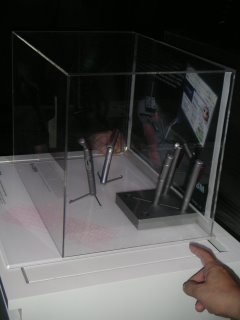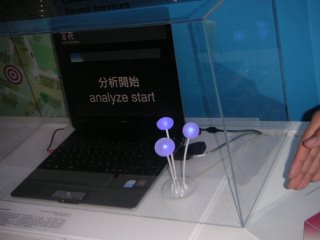Day 1:
The grouping... how it's done:
All participants arrange themselves according to the date and birth (excluding the year)... OK, interesting discovery: am having the same birthday as Darren! Also, Sai Choo is last in the queue... just wondering... is her birthday on 31 December? Charles is right at the front... 1 January?
(a) Fearsome Factor
Description
An ice-breaker whereby each group is given a list of items to find. That includes some insects that are alive, a can of coke, a bag of sea water and a ball.
Some thoughts...
- There is no competition... indeed, it's sharing... sharing of resources and collaboration... there's no win or lose... each team tried to fulfill the items in a checklist... just like everybody's sitting for the same exam.
Oops!!! That reminded me that excessive sharing and collaboration is no good! Remember the days when working with the trainee teachers in Bhutan, to help their friends, they share with other classes what is going to be tested after they sat for a test... in ended up we had to set multiple sets of questions to address to that problem, and also have to rationalise with them the objective of assessments! OK, perhaps different culture, different mindsets?
(b) 3D Icon Challenge
Description
Each group to come up with an icon and draw it on a chart paper. We get to vote for our favourite icons... pretty interesting representations.
In our group, Tze Hwei came up with one made up of 2 letters - well, depending how we want to interpret... "W" or "M" or "E" and "C" or "U"... depending on our perspectives.
Some thoughts on this...
- it's important to be able to see things from different perspectives... though it may be presented as "C" and "E"... "U" and "W"... one even saw the chinese character "山" and interpret as "稳如泰山". See! How imaginative and creative one can be! and that probably reminds us that often we are so used to see from one perspective (ours??!!!) and forget to stand back and take a look from another angle!
(c) Wells of the Deep
Description
It's really about expect the unexpected... it tested our beliefs and assumptions! Through this simple 'jig-saw' puzzle - it brings out a few human behaviours. The mental model and behaviours are quite clearly displayed in this activity.
Are we bother to look what's out there, next to us? It's just like I spotted the next group actually holding on to the printouts... hey, do we have? If not, can they share? That's what happen when we do not know what to do or how to get started off with... then look around! We may get some clue to help us get started! Of course, the other group, though holding on to a whole stack of printouts did not bother to check around if others have it or not? They are not aware that they play the role of providing the start-up support to others!
Though the puzzles are divided among 16 groups, there were only 15 sets of puzzle! So, it's testing our 'by-default' assumption! We take for granted that certain parameters must be 'constant'...
At one point, the team decided that it's better to fulfill others' wishes... and we became generous to send all our pieces away! Well, sometimes it's good to help others to succeed, isn't it? On the other hand, we were 'conned' into giving up a diagram that we were amost half finished!!! One pair came to us and said they have already had most of the pieces, except those that were with us! So, we decided to collaborate and give them what we had... guess what happened? When we 'survey' their puzzle about 10 minutes later, it was only about 2/3 completed. In my heart, just wonder... Hey, honesty counts! where's your integrity? Though it's a game, certain undesireable characteristics were surfaced! It's dissappointing, especially when it comes from an education officer!
Learnt another thing, too... that is, do not see things by the surface and immediately jump into conclusion or action (without much thinking)! For example, we started off sieving out those pictures with straight edges - which is the normal practice when working on a jigsaw puzzle... however we forget that each group could have parts of the different puzzles! One assumption... however, that was very quickly resolved when someone said, look at the back of the puzzle! We can sieve/organise by the colour at the back of the puzzle! So, do not look at the surface of things only! We need to examine the 'background' and 'rationale' before jumping into conclusion if we owe the matter or not!
(d) Where are You? In search of your cloth peg
Description
Everybody wrote our name on a cloth peg. These were collected and scattered all over the field. The team was blind-folded and led by the leader, who's the only person who can see... Then each were to get back their own 'name' peg.
Some thoughts...
The wrap-up session of this activity was good where key points were clearly highlighted by everybody...
As a leader: Give clear instructions and do not assume others share the same viewpoint (the members need guidance). It is necessary to care, motivate and give assurance to the members... that keeps the team moving.
As a follower: (I like this) Enjoy being led... yes, if we're not happy with the leader, there'll be filters that dilute the effort from both sides - and lead to low productivity. Of course, we have to know who the leader is... and when not clear, give feedback and clarify... of course, have to behave - contribute as a cooperative team leader... sometimes we do not see the overall picture and we jump into conclusion based on our limited knowledge.
(e) Over the Fire!
Description
In a circle formation: A huge blue bucket was placed in the centre, with about 15 smaller buckets placed around. Each of the smaller buckets contained 3 ping-pong balls. The objective is to transfer the ping-pong balls from the smaller buckets into the blue one. The challenge comes from the constraints... no one is allowed to step into the circle... once in, will become a 'human' barrier... the small buckets can only move towards the blue bucket... once any ping-pong ball is spilled out of the bucket, that bucketful of ping-pong balls have to re-start all over... once the 1st ball drops into the blue bucket, the rest must go in within 60 seconds!
The strategy was actually a simple one, having 2 ropes, one that comes with a moveable knot that can become tightened around the neck of the object... there it goes! yes, it requires way to 'secure' the target. Paul came up with an interesting way... ok, quite procedural, as Marako had pointed out, but it's a very good try! It may take time, but it works... yes, Marako also suggested getting masking tape to 'stick' the neck of the bucket so as to bring it over to the ones nearer, however, Timothy is quick to point out that it will require lots of resources - as each can only use once... and it effectively requires at least 15 sets of tapes and ropes! Moreover, we already ran out of the resource - masking tape! Nevertheless, it's a good try!
Some thoughts...
No harm trying attitude... that's why several strategies were tested and we eventually agreed on one way... We cheered on... though some of us are not working on the ropes... However, like what Ivan has pointed out... somethings we forgot being spectators or funs, we unknowningly become 'barriers'... good point, something to be mindful with.
A group went on to play soccer at the other side of the field... what's our interpretation? "Bo-chap" attitude? This is one way that we can perceive... another perspective (hm... perhaps some of us will think that this group is trying to defend their act)... as they explained... since they knew that things are in order and progressing, and they will not be able to contribute, so they look for other things to do! One of the guys actually realistically pointed out that in the real life situation, if they see that their job has been taken over by someone, they will start to look for other areas when they can be engaged in... hm... so that means including moving on to greener pastures? This brings to another point: Does the organisation value its people? Do the people feel it? If one does not feel not valued, I agree, one will start to look elsewhere to where people value and appreciate one's existence!
Day 2:
The day started off with a video clip... "Be my Guest". It's an interesting one! It generated lots of laughters! It pointed out the expectations of 'customers' apart from the actual business that one deals with, but the PR/HR that many a time, we take for granted! Especially internal customer! Things go strain when one does not take care of this... and that leads to unproductivity... Just wonder what goes in the minds of the audience as they watched the clip... did everyone of us started to reflect and realised that are lots more that we can do... Customer Service!
(f) Grooming
A few areas were touched on... Grooming, Etiquettes - Email & Phone...
Thought it was quite an exciting time when each pointed out what's expected of, especially in terms of social etiquette and grooming of the opposite sex. Oh yes, I was indeed caught in big surprises of some of the "don'ts"... you mean it happened in the ministry? Our colleagues do not know what's decent? Based on some descriptors, it shocked me when one asked the guys ensure there is enough cloth to cover their bodies? Similarly to the ladies!!! About leg hairs? About the hair? There are those who yet bother to dress themselves in a decent enough manner... One new thing I learnt: There's this IM for dress code! Great.. perhaps will find sometime to take a look...
(g) Building the Structure...
Building a structure so that the marble, after falling through at least a height of 1m will roll to for a distance of nearly but not yet 1m. It's a challenge, isn't it? Given a rope, 2 flip chart papers, some A4 papers, a tube of glue, and a roll of masking tape.
Some thoughts...
The one who's most 'hands-on' will take charge? Hm... that's basically what I observe... at least in my group... on the other hand, it's probably... 'by nature' of personality? and probably whose brain most active? and one who talks most? Ok, also a fact - ie. when the few people who know each other well, sometimes they'll forget who else around... and to take note of other voices...
(h) The castaway... The caterpillar game
Description
Everyone blew a balloon... and the balloon was sandwiched between the human bodies... forming a caterpillar that moved down to the badminton court to collect some stuff before coming back... and eventually all come together to use balloons to form the ETD logo...
Some thoughts...
Well, this activity once again emphasizes on teamwork... and having the consideration for all... in order to succeed. As we walked off as a catepillar, realised some 'interesting' characters that are quite distinctive of one of the sections - the very jovial group who we can find the child in them, that was basically exhibited through their behaviour... and forgetting about the rest... This crossed my mind - I have not crossed path with them in my work... If I would have... it's going to drive me to the wall!!! Trying 'childish' ways to 'win' the game! It happens here!!! I guess... maturity...
~~~~~~~~~~~~~~~~~~~~~~~~~~~~~~~~~~~~~~~~~~~












